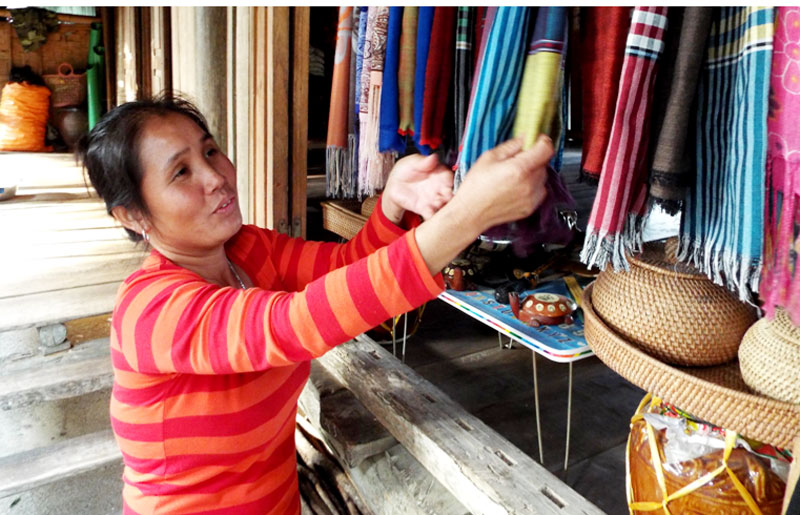
HBO – Giang Mo village in Binh Thanh commune (Cao Phong district) has been become an outstanding Muong cultural highlight for years. Separating from smoke and noise of urban areas, the picturesque romantic vista of Giang Mo is an ideal destination for those who want to find tranquility. Furthermore, this is one of the ethnic-inhabitedvillages which is defined by the provincial tourism sector to become a spearhead product to attract visitors when talking about Hoa Binh.

Brocade products made by
Giang
Molocals are displayed to sell for tourists
Peaceful
Giang
Mo village
is located in the foot of Mo Mountain, about 12km from Hoa Binh city’s downtown.
It is not difficult to reach the village. The village is home to 145 households
who all belong to the Muong ethnic group. It is considered an alive
museum of
Muong ethnics’ traditional culture as
there remains the traditional architecture of stilt houses, looms of Muong
ethnics, and work tools such as rice mortars, bows, cross-bows, and tools for
mountain field works.
Visiting Giang Mo today,
tourists can walk on the small path running throughout the village, contemplate
the untouched beauty of the nature, and can stop at any stilt house to learn
about Muong culture, enjoy bamboo pole dances beside jars of ruou can (a kind
of wine drunk out of a jar through pipes), and experience daily work of locals
such as caring for poultry and cattle, doing field work, hunting for animals
and picking fruits.
Visitors are also offered a
chance to listen to Muong young women’s stories about weaving and traditional brocade
products such as clothes, bags and scarves and enjoy Muong people’s dishes such
as steamed sticky rice, pork, hill vegetables and spring fish.
At this time, visitors can
also enjoy fresh air and smell the fragrance of rice which is being harvested.
Tran Quang Minh, a second-year student of the
Universityof
Culture said: "My classmates
decided to choose
Giang
Mo to visit. This tour helps us understand
more about the life and daily activities of Muong ethnics and have interesting
first-ever experience such as weaving brocade, throwing "con” (a
cloth ball) through a ring or shooting with a crossbow with local children. We
have noteworthy memories in this beautiful village”.
Village head Nguyen Van
Hau said: "
Giang
Mo village
welcomes thousands of visitors, from inside and outside the country each year.
We are trying to increase the quality of services to make tourists comfortable.
We pay attention to keeping everything clean, from houses, alleys to bedding.
Specially, the village controls locals’ insistence on buying goods”.
All these things create typical
features of
Giang
Mo village. Therefore, although
Giang
Mois not an impressive ecological tourist site with specular natural landscapes
or a services tourist attraction with professional products, it gently attracts
visitors with its plain beauty and the heartiness of local residents./.
A diverse chain of eco-tourism and resort destinations concentrated in Hoa Binh city and the districts of Tan Lac, Da Bac, and Luong Son… Along with the launch of several key high-quality resort tourism projects, these developments have reshaped the landscape and enhanced the appeal of Hoa Binh as a travel destination.
Boasting diverse terrain, a mild climate, and rich natural resources, Cao Phong district is increasingly asserting its place on Vietnam’s tourism map, attracting both domestic and foreign visitors. The district is renowned for its stunning landscapes, majestic mountains, a crystal-clear hydropower lake, and the unique cultural identity of local ethnic groups.
With its pristine landscapes, unique cultural heritage of Muong ethnic minority, and an expanding range of visitor experiences, Tan Lac district of Hoa Binh has fast become a captivating destination for both domestic and international tourists.
Until now, Sung village in Cao Son commune, Da Bac district remains the only Dao ethnic community in Hoa Binh province to develop a community-based tourism model. Beyond its untouched natural landscapes, cultural identity serves as the cornerstone attraction for visitors.
Alongside the diverse cultural identities of the Kinh, Muong, Tay, Thai, Dao, and Mong ethnic people, Hoa Binh province is also renowned as the "capital" of the northwestern Vietnamese cuisine, offering unique and distinctive dishes. At festivals, during Lunar New Year (Tet), or on significant family or community occasions, special dishes are prepared, leaving a lasting impression on visitors.
A Phong Linh (Yellow Tabebuia) flower garden in Thang village, Thach Yen commune, Cao Phong district is currently in full bloom, drawing a large number of visitors.



